Prediction of Bay-Shaped Shorelines between Detached Breakwaters with Various Gap Spacings
Abstract
:1. Introduction
2. Numerical Model
2.1. XBeach Model
2.2. Initial Bathymetry
2.3. Model Settings
3. Numerical Results
3.1. Validations
3.2. Hydrodynamic and Morphodynamic Processes
4. Discussion
4.1. Shorelines and Bottom Profiles for Various Gap Spacings
4.2. Regression Analysis of Shoreline Retreat Displacement
4.3. Validation in Practical Scenarios
- (1)
- Determine the diffraction point or up-coast control point (i.e., the heads of the adjacent offshore breakwaters).
- (2)
- Determine the point tangent to the bay (i.e., the distance Xe at the centerline between two adjacent offshore breakwaters) by using Equation (1).
- (3)
- Locate the wave crest direction tangent to the downcoast shoreline. In this study, because of the normally incident persistent wave direction, the crest wave line was parallel to the offshore breakwaters.
5. Conclusions
Author Contributions
Funding
Informed Consent Statement
Data Availability Statement
Conflicts of Interest
References
- Toyoshima, O. Design of a detached breakwater system. Coast. Eng. 1974, 14, 1419–1431. [Google Scholar] [CrossRef]
- Toyoshima, O. Variation of Foreshore due to detached breakwaters. Coast. Eng. Proc. 1982, 18, 1873–1892. [Google Scholar] [CrossRef]
- Noble, R.M. Coastal structures’ effects on shorelines. Coast. Eng. Proc. 1978, 16, 2069–2085. [Google Scholar] [CrossRef]
- Nir, Y. Offshore artificial structures and their influence on the Israel and Sinai Mediterranean beaches. Coast. Eng. Proc. 1982, 18, 1837–1856. [Google Scholar] [CrossRef] [Green Version]
- Noda, H. Depositional effects of offshore breakwater due to onshore–offshore sediment movement. Coast. Eng. Proc. 1984, 19, 2009–2025. [Google Scholar] [CrossRef] [Green Version]
- Harris, M.M.; Herbich, J.B. Effects of breakwater spacing on sand entrapment. J. Hydraul. Res. 1986, 24, 347–357. [Google Scholar] [CrossRef]
- Fairley, I.; Davidson, M.; Kingston, K.; Dolphin, T.; Phillips, R. Empirical orthogonal function analysis of shoreline changes behind two different designs of detached breakwaters. Coast. Eng. 2009, 56, 1097–1108. [Google Scholar] [CrossRef]
- Jaramillo, C.; Jara, M.S.; González, M.; Medina, R. A shoreline evolution model for embayed beaches based on cross-shore, planform and rotation equilibrium models. Coast. Eng. 2021, 169, 103983. [Google Scholar] [CrossRef]
- Lesser, G.R.; Roelvink, J.A.; van Kester, J.A.T.M.; Stelling, G.S. Development and validation of a three-dimensional morphological model. Coast. Eng. 2004, 51, 883–915. [Google Scholar] [CrossRef]
- Fernando, P.T.; Pan, S. Modelling wave of hydrodynamics around a scheme of detached leaky breakwaters. Coast. Eng. 2005, 4, 830–841. [Google Scholar] [CrossRef]
- Li, M.; Fernando, P.T.; Pan, S.; O’Connor, B.A.; Chen, D. Development of a quasi-3d numerical model for sediment transport prediction in the coastal region. J. Hydro-Environ. Res. 2007, 1, 143–156. [Google Scholar] [CrossRef]
- Wang, B.; Reeve, D. Probabilistic modelling of long-term beach evolution near segmented shore-parallel breakwaters. Coast. Eng. 2010, 57, 732–744. [Google Scholar] [CrossRef]
- Tang, J.; Lyu, Y.; Shen, Y.; Zhang, M. Numerical study on influences of breakwater layout on coastal waves, wave-induced currents, sediment transport and beach morphological evolution. Ocean. Eng. 2017, 141, 375–387. [Google Scholar] [CrossRef]
- Mory, M.; Ham, L. Wave height, setup and currents around a detached breakwater submitted to regular or random wave forcing. Coast. Eng. 1997, 31, 77–96. [Google Scholar] [CrossRef]
- Gourlay, M.R. Wave set-up and wave generated currents in the lee of a breakwater or headland. In Proceedings of the 14th International Conference on Coastal Engineering, Copenhagen, Denmark, 24–28 June 1974. [Google Scholar]
- Van Rijn, L.C. Detached Breakwaters. 2018. Available online: www.leovanrijn-sediment.com (accessed on 13 November 2019).
- Araújo, M.A.V.C.; Di Bona, S.; Trigo-Teixeira, A. Impact ofdetached breakwaters on shoreline evolution: A case study on the Portuguese west coast. J. Coast. Research. 2014, 70, 41–46. [Google Scholar] [CrossRef]
- Hanson, H. GENESIS—A Generalized Shoreline Change Numerical Model. J. Coast. Res. 1989, 5, 1–27. [Google Scholar]
- Guimarães, A.; Coelho, C.; Veloso-Gomes, F.; Silva, P. Modelling Shoreline Impacts of Detached Breakwaters: LTC and GENESIS Comparison. Coast. Struct. Conf. 2019, 782–790. [Google Scholar] [CrossRef]
- Coelho, C. Riscos de Exposição de Frentes Urbanas Para Diferentes Intervenções de Defesa Costeira. Ph.D. Thesis, Civil Engineering Department, University of Aveiro, Aveiro, Portugal, 2005; p. 404. [Google Scholar]
- de Macêdo, R.J.A.; Manso, V.D.A.V.; da Fontoura Klein, A.H. The geometric relationships of salients and tombolos alonga mesotidal tropical coast. Geomorphology 2022, 411, 108311. [Google Scholar] [CrossRef]
- Klein, A.H.F.; Junior, N.A.; Menezes, J.T. Shoreline salients and tombolos on the Santa Catarina coast (Brazil): Description and analysis of the morphological relationships. J. Coast. Res. 2002, SI 36, 425–440. [Google Scholar] [CrossRef]
- Dally, W.R.; Pope, J. Detached Breakwaters for Shore Protection; Department of the Army Waterways Experiment Station, Corps of Engineers: Vicksburg, MI, USA, 1986. [Google Scholar]
- Suh, K.; Dalrymple, R.A. Offshore Breakwaters in Laboratory and Field. J. Waterw. Port Coast. Ocean. Eng. 1987, 113, 2. [Google Scholar] [CrossRef]
- Bricio, L.; Negro, V.; Diez, J.J. Geometric detached breakwater indicators on the Spanish Northeast Coastline. J. Coast. Res. 2008, 24, 1289–1303. [Google Scholar] [CrossRef]
- Hsu, J.R.C.; Silvester, R. Accretion behind single offshore breakwaters. J. Waterw. Port Coast. Ocean. Eng. 1990, 116, 362–380. [Google Scholar] [CrossRef]
- Hsu, J.R.C.; Evans, C. Parabolic bay shapes and applications. Proc. Inst. Civ. Eng. 1989, 87, 557–570. [Google Scholar] [CrossRef]
- Hsu, J.R.C.; Uda, T.; Silvester, R. Beaches downcoast of harbours in bays. Coast. Eng. 1993, 19, 163–181. [Google Scholar] [CrossRef]
- Hsu, J.R.C.; Silvester, R. Stabilizing beaches downcoast of harbor extension. In Proceedings of the 25th International Conference on Coastal Engineering, Orlando, FL, USA, 2–6 September 1996; Volume 4, pp. 3986–3999. [Google Scholar] [CrossRef]
- Smith, G.G.; Dunkley, E.; Soltau, C. Shoreline response to harbour developments in Table Bay. In Proceedings of the 27th International Conference on Coastal Engineering, Sydney, Australia, 16–21 July 2000; Volume 3, pp. 2822–2835. [Google Scholar] [CrossRef]
- Benedet, L.; Klein, A.H.F.; Hsu, J.R.C. Practical insights and applicability of empirical bay shape equations. In Proceedings of the 29th International Conference on Coastal Engineering, Lisbon, Portugal, 19–24 September 2004; Volume 2, pp. 2181–2193. [Google Scholar] [CrossRef]
- Hsu, J.R.C.; Benedet, L.; Klein, A.H.F.; Raabe, A.L.A.; Tsai, C.P.; Hsu, T.W. Appreciation of Static Bay Beach Concept for Coastal Management and Protection. J. Coast. Res. 2008, 24, 198–215. [Google Scholar] [CrossRef]
- Hsu, J.R.C.; Lee, J.L.; Klein, A.H.F.; Mauricio, G.; Medina, R. Headland-bay Beaches: Static Equilibrium Concept for Shoreline Management. Adv. Ser. Ocean. Eng. 2012, 53, 812. [Google Scholar] [CrossRef]
- Klein, A.H.F.; Vargas, A.; Raabe, A.L.A.; Hsu, J.R.C. Visual assessment of bayed beach stability using computer software. Comput. Geosci. 2003, 29, 1249–1257. [Google Scholar] [CrossRef]
- Hsu, J.R.C.; Yu, M.M.J.; Lee, F.C.; Silvester, R. Headland-Bay Beaches for Recreation and Shore Protection. Handb. Coast. Ocean. Eng. 2009, 825–842. [Google Scholar] [CrossRef]
- Roelvink, D.; Reniers, A.; van Dongeren, A.; van Thiel de Vries, J.; McCall, R.; Lescinski, J. Modelling storm impacts on beaches, dunes and barrier islands. Coast. Eng. 2009, 56, 1133–1152. [Google Scholar] [CrossRef]
- Roelvink, D.; McCall, R.; Mehvar, S.; Nederhoff, K.; Dastgheib, A. Improving predictions of swash dynamics in XBeach: The role of groupiness and incident-band run up. Coast. Eng. 2018, 134, 103–123. [Google Scholar] [CrossRef]
- De Vet, P.L.M.; McCall, R.T.; Den Bieman, J.P.; van Ormondt, M.; Stive, M.J.F. Modelling dune erosion, overwash and breaching at fire island (NY) during hurricane sandy. In Proceedings of the Coastal Sediment, San Diego, CA, USA, 11–15 May 2015; pp. 1–10. [Google Scholar] [CrossRef] [Green Version]
- Nederhoff, C.M.; Lodder, Q.J.; Boers, M.; Den Bieman, J.P.; Miller, J.K. Modeling the effects of hard structures on dune erosion and overwash—A case study of the impact of Hurricane Sandy on the New Jersey coast. In Proceedings of the Coastal Sediments, San Diego, CA, USA, 11–15 May 2015. [Google Scholar] [CrossRef] [Green Version]
- Splinter, K.D.; Carley, J.T.; Golshani, A.; Tomlinson, R. A relationship to describe the cumulative impact of storm clusters on beach erosion. Coast. Eng. 2014, 83, 49–55. [Google Scholar] [CrossRef]
- de Winter, R.C.; Gongriep, F.; Ruessink, B.G. Observations and modeling of alongshore variability in dune erosion at Egmond aan Zee, The Netherlands. Coast. Eng. 2015, 99, 167–175. [Google Scholar] [CrossRef]
- Smallegan, S.M.; Irish, J.L.; van Dongeren, A.R. Developed barrier island adaptation strategies to hurricane forcing under rising sea levels. Clim. Change 2017, 143, 173–184. [Google Scholar] [CrossRef]
- Fried, I. Protection by means of offshore breakwaters. Coast. Eng. Proc. 1976, 15, 1407–1424. [Google Scholar] [CrossRef] [Green Version]
- Rosen, D.S.; Vajda, M. Sedimentological influences of detached breakwaters. In Proceedings of the 18th International Conference on Coastal Engineering, Cape Town, South Africa, 14–19 November 1982; Volume 18, pp. 1930–1948. [Google Scholar] [CrossRef]
- Nir, Y. Detached Breakwaters, Groynes and Artificial Structures on the Mediterranean Shore and Their Influence on the Structure of the Israeli Shore; Report No. 3, 76/2; Ministry of Industry and Commerce, Geological Institute, Marine Geology Section: Jerusalem, Israel, 1976. [Google Scholar]
- Berenguer, J.M.; Enriquez, J. Design of pocket beaches. The Spainish case. In Proceedings of the 21st International Conference on Coastal Engineering, Costa del Sol-Malaga, Spain, 20–25 June 1988; pp. 1411–1425. [Google Scholar] [CrossRef]
- Uda, T. Statistical analysis of detached breakwaters in Japan Coastal Engineering. Coast. Eng. Proc. 1988, 21, 2028–2042. [Google Scholar] [CrossRef] [Green Version]
- González, M.; Medina, R. On the application of static equilibrium bay formulations to natural and man-made beaches. Coast. Eng. 2001, 43, 209–225. [Google Scholar] [CrossRef]
- Khuong, T.C. Shoreline Response to Detached Breakwaters in Prototype. Doctoral Dissertation, Delft University of Technology, Delft, The Netherlands, 2016. [Google Scholar] [CrossRef]
- McCall, R.T.; Van Thiel de Vries, J.S.M.; Plant, N.G.; Van Dongeren, A.R.; Roelvink, J.A.; Thompson, D.M.; Reniers, A.J.H.M. Two-dimensional time dependent hurricane overwash and erosion modeling at Santa Rosa Island. Coast. Eng. 2010, 57, 668683. [Google Scholar] [CrossRef]
- Splinter, K.D.; Palmsten, M.L. Modeling dune response to an east coast low. Mar. Geol. 2012, 329–331, 46–57. [Google Scholar] [CrossRef]
- Van Geer, P.; den Bieman, J.; Hoonhout, B.; Boers, M. XBeach 1D—Probabilistic model: ADIS, Settings, Model uncertainty and Graphical User Interface. Tec. Rep. 2015, 1209436, 65. [Google Scholar]
- Do, K.; Shin, S.; Cox, D.; Yoo, J. Numerical Simulation and Large-Scale Physical Modelling of Coastal Sand Dune Erosion. J. Coast. Res. 2018, 85, 196–200. [Google Scholar] [CrossRef]
- Roelvink, J.A. Coastal morphodynamic evolution techniques. Coast. Eng. 2006, 53, 277–287. [Google Scholar] [CrossRef]
- Vousdoukas, M.I.; Almeida, L.P.; Ferreira, Ó. Modelling storm-induced beach morphological change in a meso-tidal, reflective beach using XBeach. J. Coast. Res. 2011, 64, 1916–1920. [Google Scholar] [CrossRef]
- Razak, M.S.; Nor, N.A.Z.M. XBeach process-based modelling of coastal morphological features near breakwater. MATEC Web Conf. 2018, 203, 1007. [Google Scholar] [CrossRef] [Green Version]
- Vieira, B.F.V.; Pinho, J.L.S.; Barros, J.A.O.; Carmo, J.S.A. Hydrodynamics and morphodynamics performance assessment of three coastal protection structures. J. Mar. Sci. Eng. 2020, 8, 175. [Google Scholar] [CrossRef] [Green Version]
- Shimizu, T.; Maruyama, K.; Kajima, R.; Saito, S. Characteristics of Field Type Measuring Equipments Tested in a Large Wave Flume Wave Gages, Current Meters, and Depthmeters; Civil Engineering Labrotary Report; CRIEPI: Tokyo, Japan, 1983. (In Japanese) [Google Scholar]
- Dean, R.G. Equilibrium Beach Profiles: U.S. Atlantic and Gulf Coasts; Technical Report No. 12; University of Delaware: Newark, Delaware, 1977. [Google Scholar]
- Van Rijn, L.C. Principles of Sediment Transport in Rivers, Estuaries and Coastal Seas. 1993. Available online: www.aquapublications.nl (accessed on 13 November 2019).

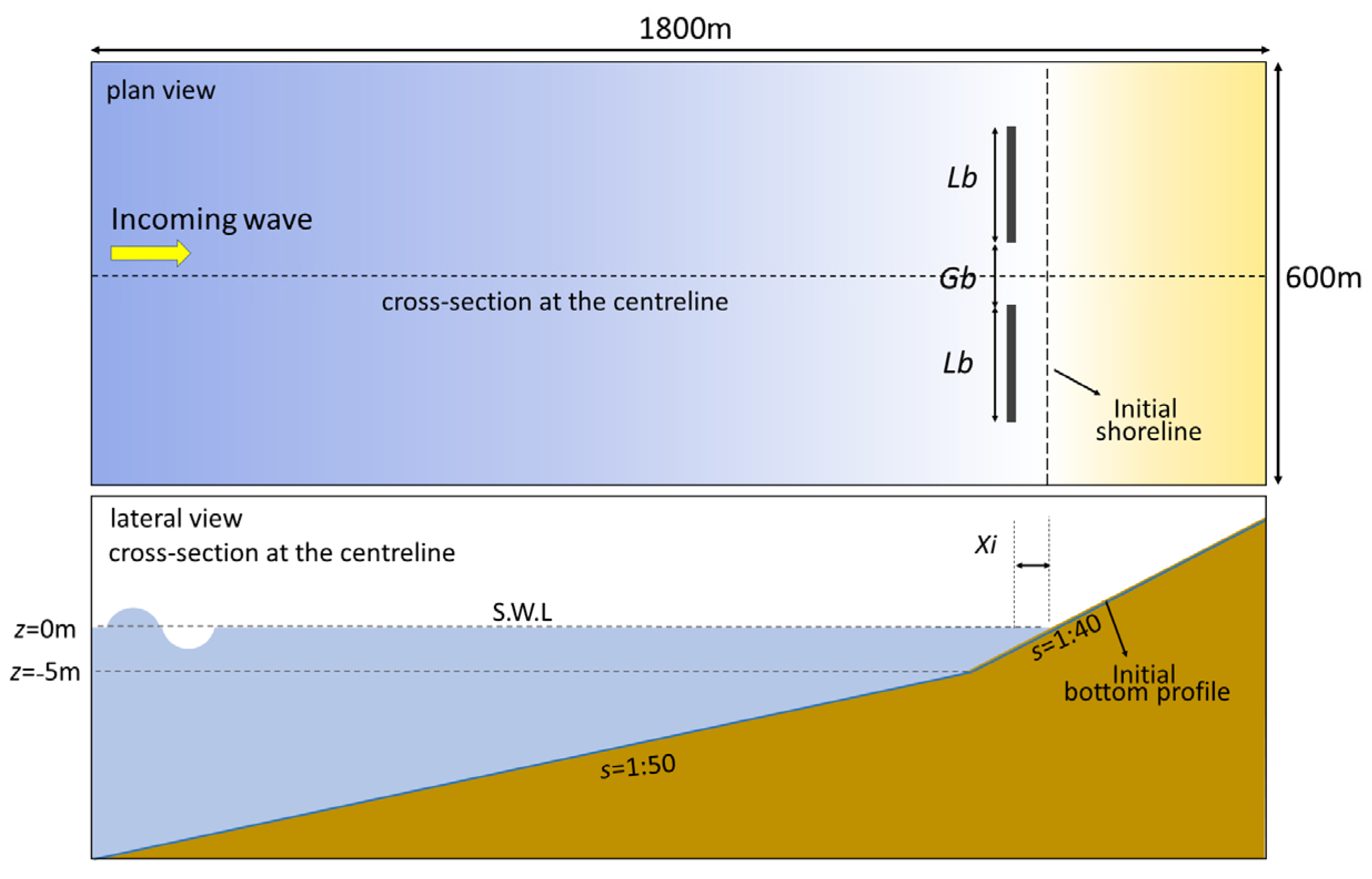
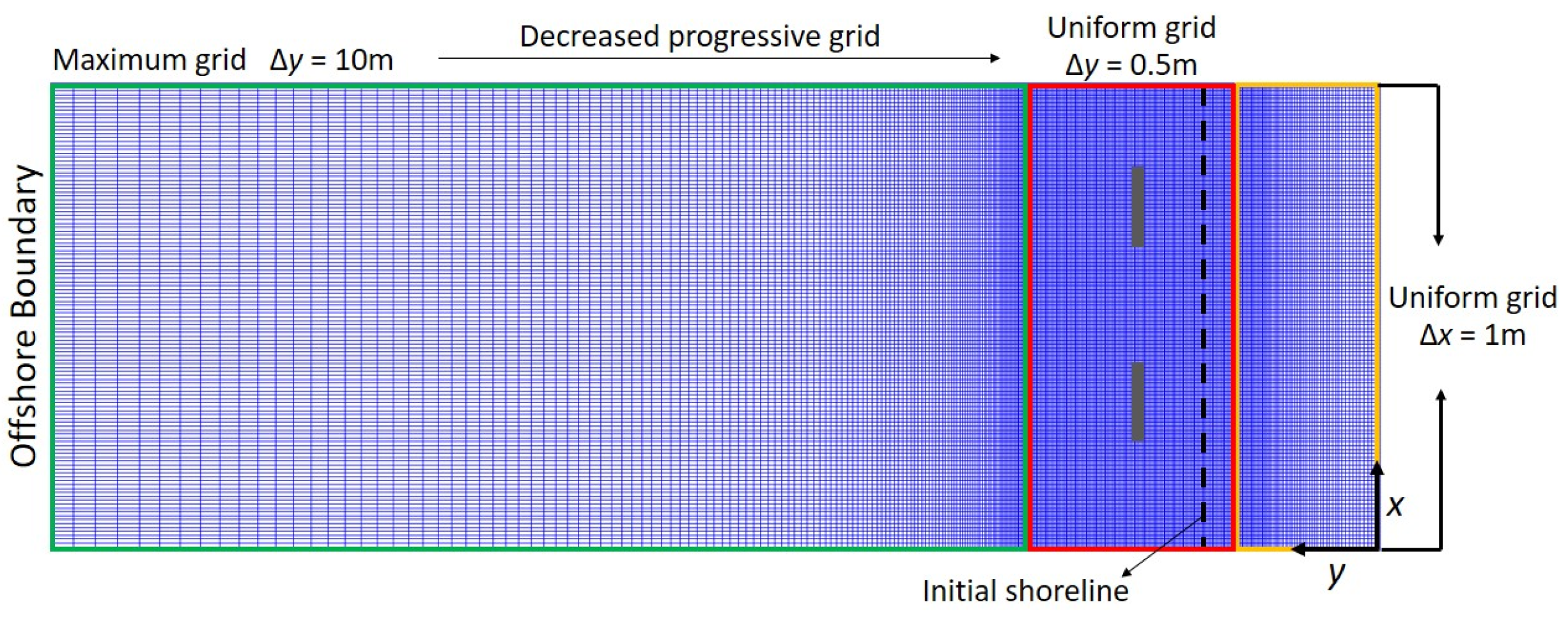
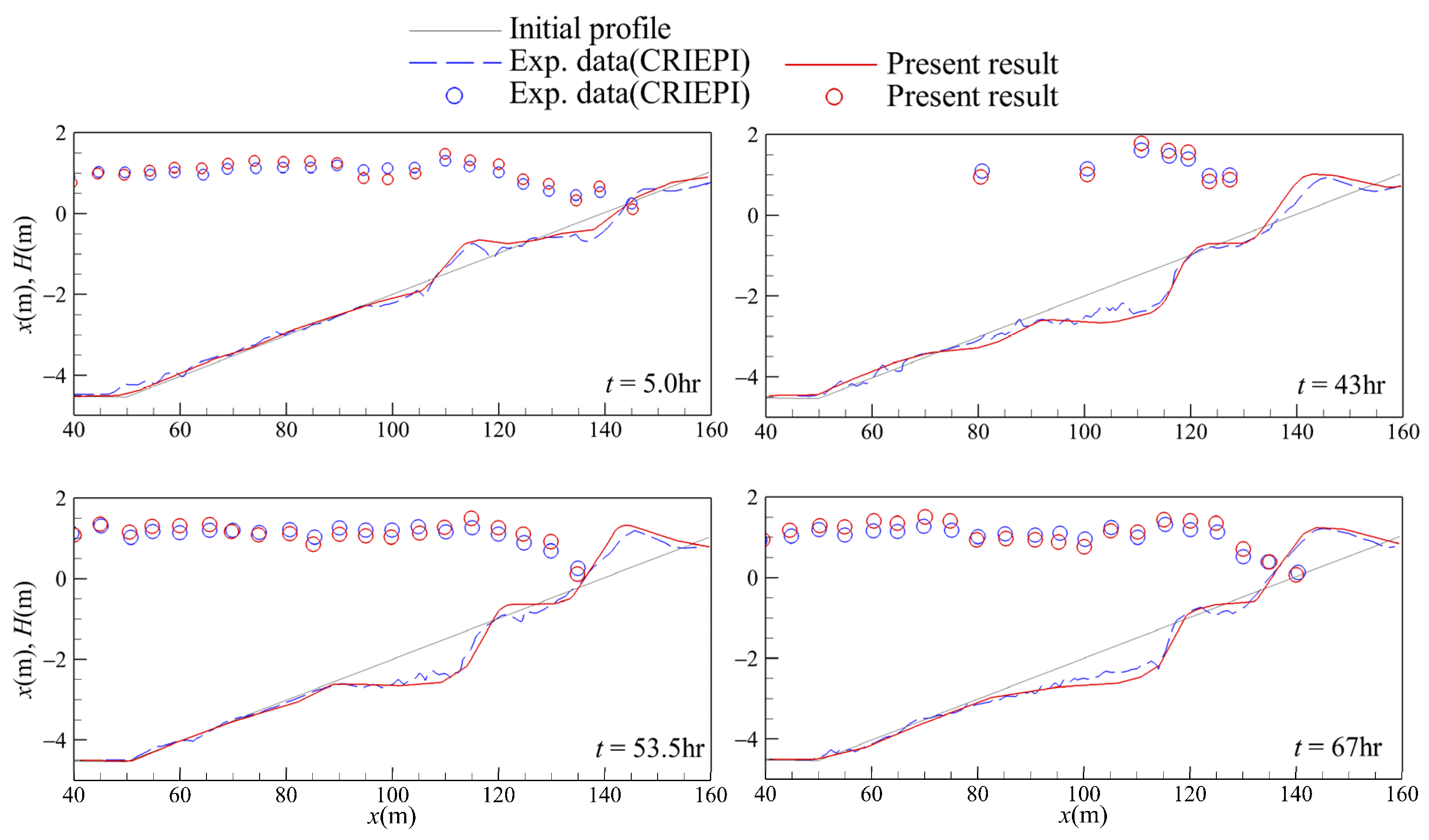


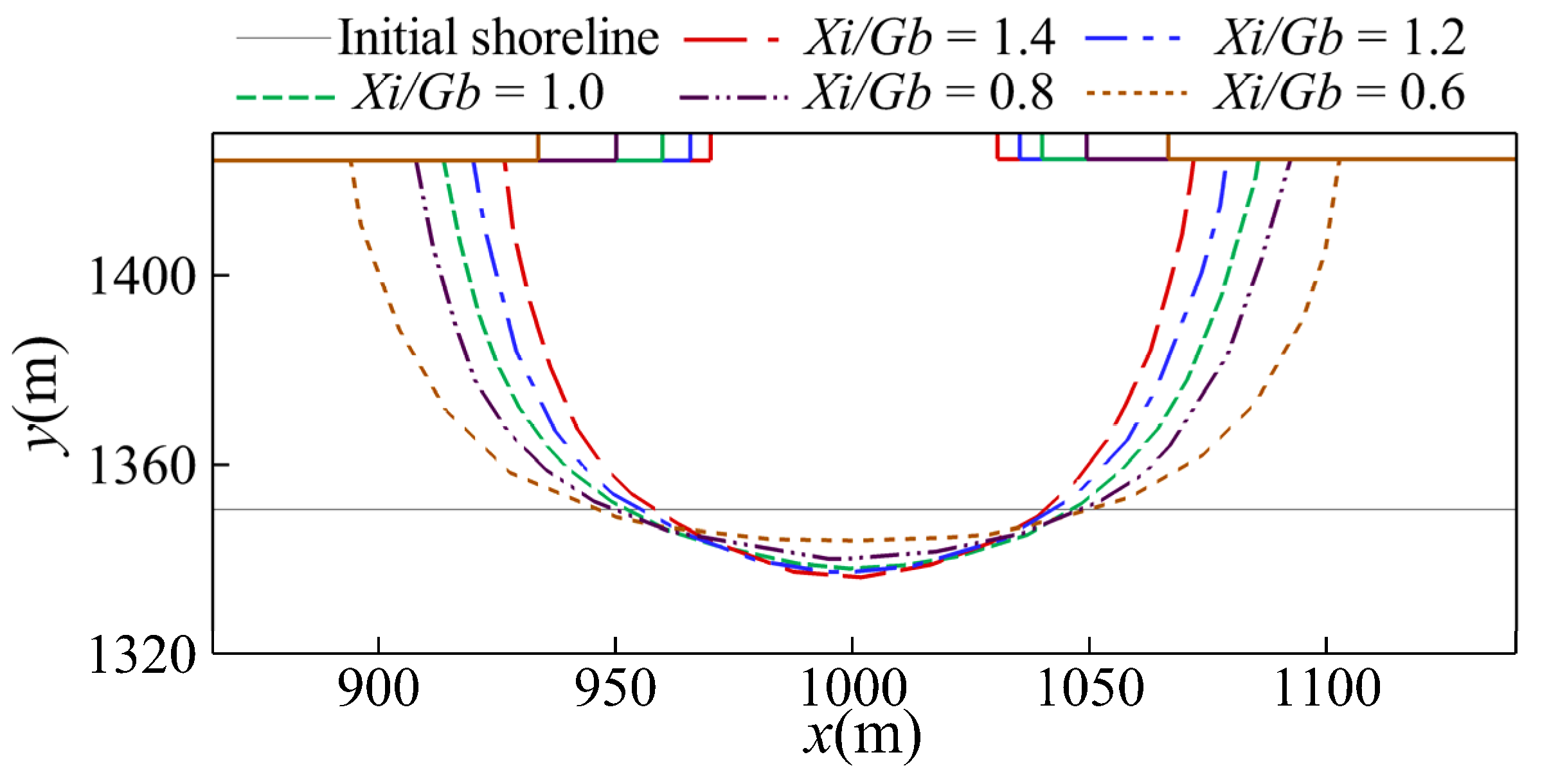
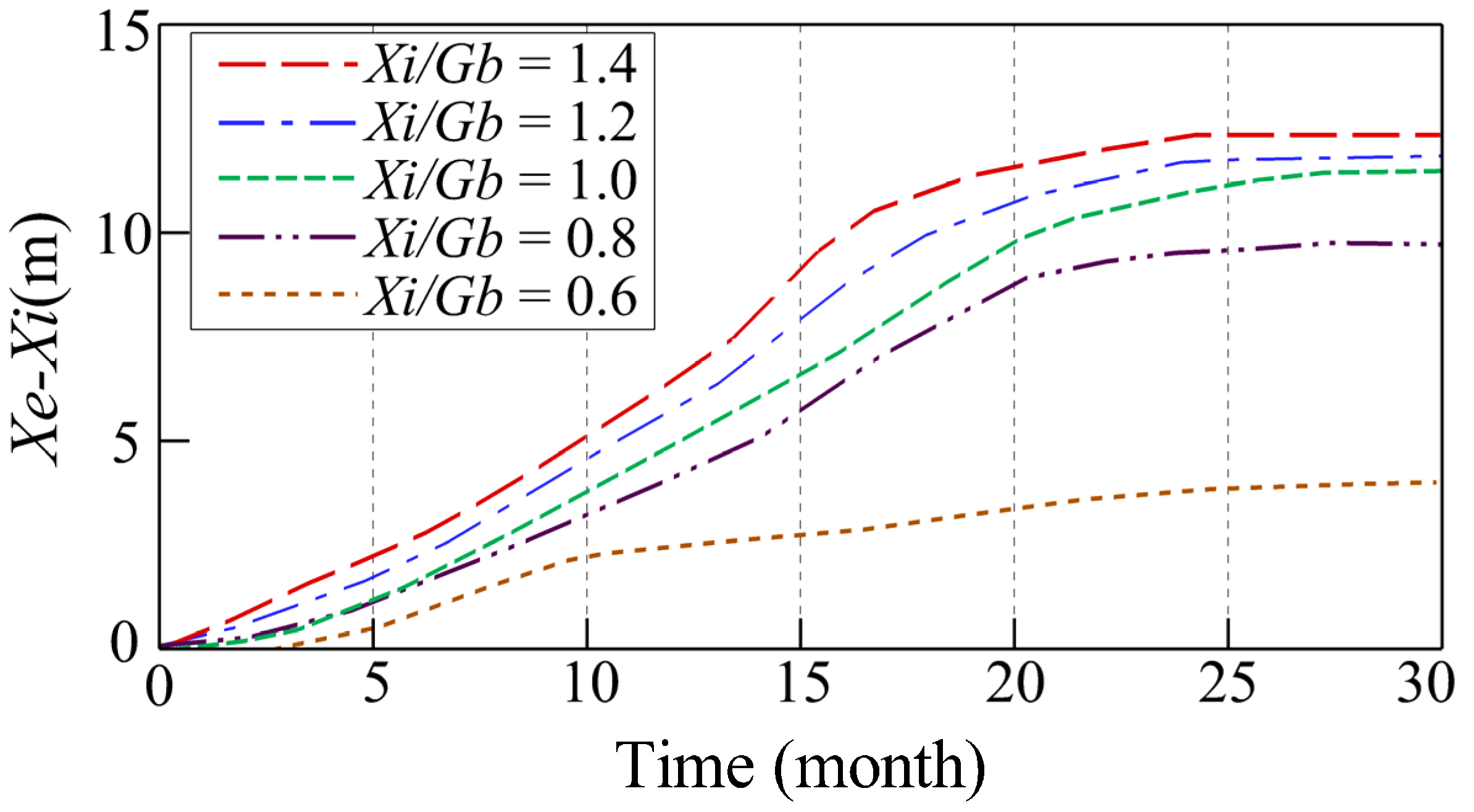



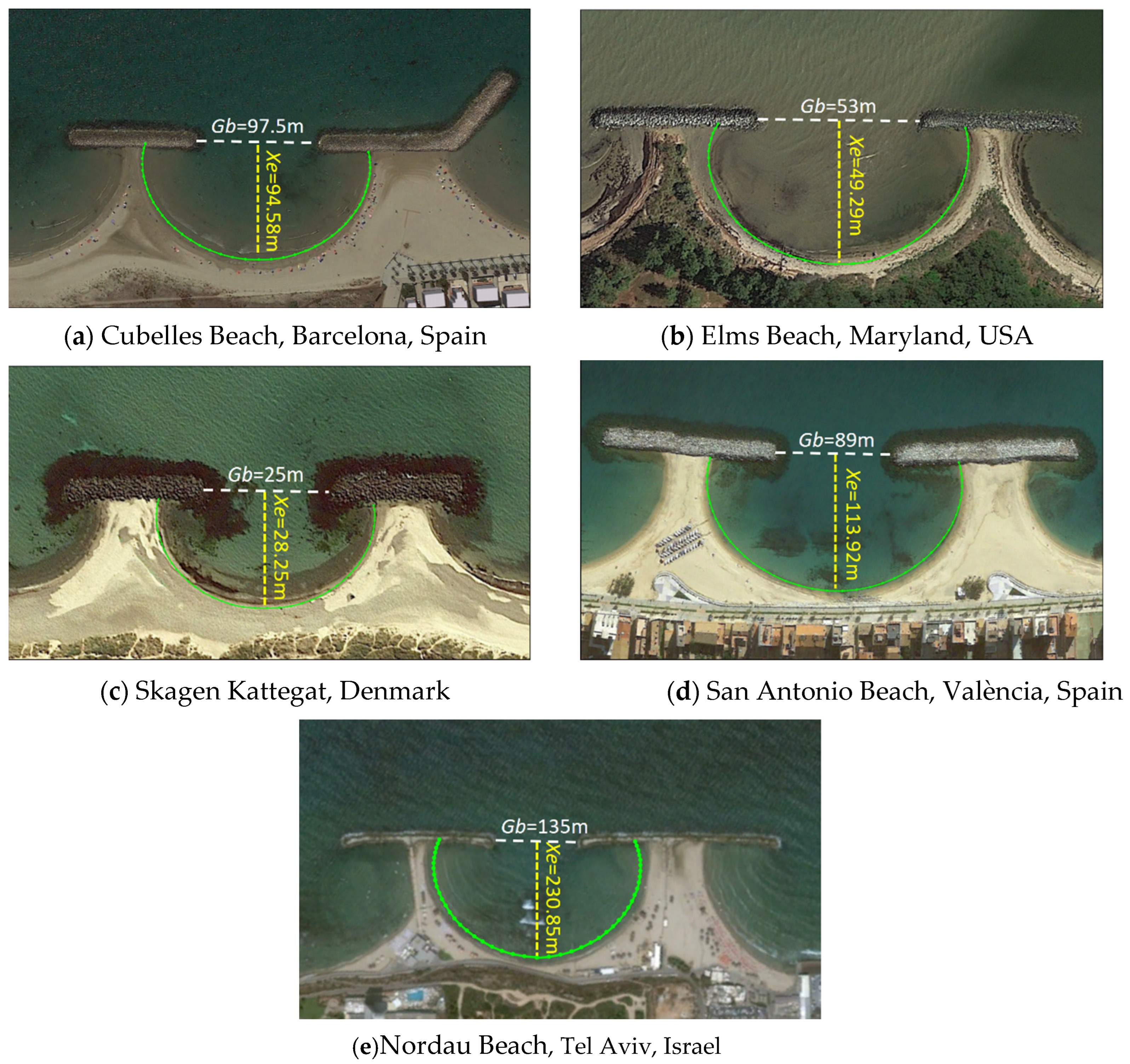
| Gb (m) | Xi (m) | Lb (m) | Lb/Xi | Gb/Lb | Xi/Gb |
|---|---|---|---|---|---|
| 58 | 80 | 150 | 1.875 | 0.39 | 1.4 |
| 67 | 0.45 | 1.2 | |||
| 80 | 0.53 | 1 | |||
| 100 | 0.67 | 0.8 | |||
| 133 | 0.89 | 0.6 |
| Xi (m) | Gb (m) | Xi/Gb | Xe/Gb (Predicted) | Xe (m) (Predicted) | |
|---|---|---|---|---|---|
| Cubelles Beach, Barcelona, Spain | 83.4 | 97.5 | 0.86 | 0.97 | 94.58 |
| Elm’s Beach, Maryland, USA | 44 | 53 | 0.83 | 0.93 | 49.29 |
| Skagen Kattegat, Denmark | 25 | 25 | 1. | 1.13 | 28.25 |
| San Antonio beach, València, Spain | 100 | 89 | 1.12 | 1.28 | 113.92 |
| Nordau Beach, Tel Aviv, Israel | 200 | 135 | 1.48 | 1.71 | 230.85 |
Disclaimer/Publisher’s Note: The statements, opinions and data contained in all publications are solely those of the individual author(s) and contributor(s) and not of MDPI and/or the editor(s). MDPI and/or the editor(s) disclaim responsibility for any injury to people or property resulting from any ideas, methods, instructions or products referred to in the content. |
© 2023 by the authors. Licensee MDPI, Basel, Switzerland. This article is an open access article distributed under the terms and conditions of the Creative Commons Attribution (CC BY) license (https://creativecommons.org/licenses/by/4.0/).
Share and Cite
Tsai, C.-P.; Chen, Y.-C.; Ko, C.-H. Prediction of Bay-Shaped Shorelines between Detached Breakwaters with Various Gap Spacings. Sustainability 2023, 15, 6218. https://doi.org/10.3390/su15076218
Tsai C-P, Chen Y-C, Ko C-H. Prediction of Bay-Shaped Shorelines between Detached Breakwaters with Various Gap Spacings. Sustainability. 2023; 15(7):6218. https://doi.org/10.3390/su15076218
Chicago/Turabian StyleTsai, Ching-Piao, Ying-Chi Chen, and Chun-Han Ko. 2023. "Prediction of Bay-Shaped Shorelines between Detached Breakwaters with Various Gap Spacings" Sustainability 15, no. 7: 6218. https://doi.org/10.3390/su15076218





